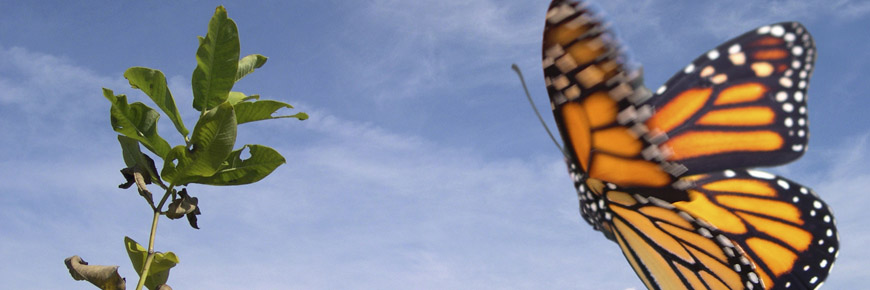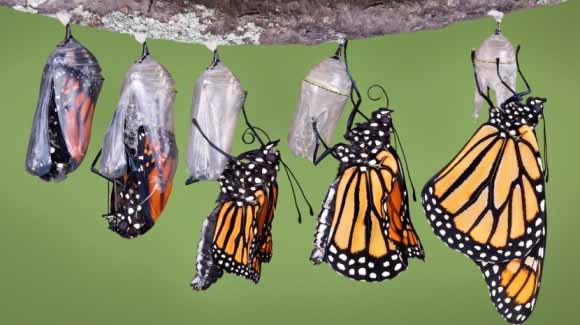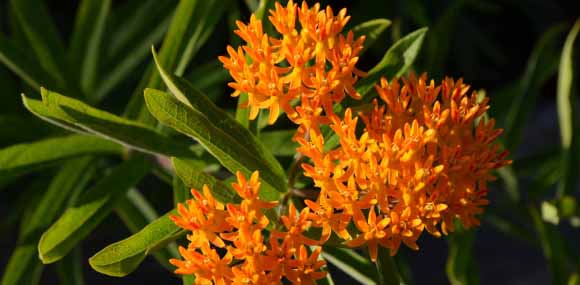
Monarch butterflies
Point Pelee National Park
Monarch butterflies are one of the most recognizable species in Canada. While they have been spotted on almost every continent in the world and colonies have established in some tropical climates, the migratory population of North America is a unique natural phenomena.
For a few special days each autumn, Point Pelee is a temporary home to thousands of migrating Monarch butterflies. As soon as favourable conditions occur, they begin one of nature’s greatest journeys by crossing Lake Erie. They cannot linger, for their destination is some 3000 km further south, in the mountains of central Mexico! Why would this tiny insect make such a monumental journey? The answer lies in the Monarch’s food plant.
Life Story of the Monarch Butterfly

Life begins as a tiny egg laid on the leaf of a milkweed plant. It develops for 4-5 days before it hatches a tiny caterpillar, so small it’s hard to see with the naked eye. Caterpillars spend about 2 weeks munching away on milkweed leaves growing from microscopic to 5 cm in length. The toxins in the milkweed plant are incorporated into the body of the monarch caterpillar and later the adult, making them taste terrible and preventing many predators, like birds, from eating them.
When large enough, the caterpillar will hang from a leaf in a “j formation” and begin the magical process of becoming a chrysalis. In this stage, watch for the antennae to twist into a corkscrew – the skin will then split, revealing a writhing green mass which soon hardens to form a chrysalis. In 12 to 16 days, the outside of the chrysalis will change from green to clear and the butterfly will emerge shortly thereafter. After pumping fluid into the wings and drying, the adult will be ready to fly off and start the process all over again.
Most adult monarchs live for about a month, during which they will mate and lay eggs. One special generation will live for more than 6 months. Monarchs that emerge in late August and September don’t have the urge to reproduce – instead, they migrate. All energy is put into creating fat stores allowing the butterflies to make the incredible journey over 3000 kilometres to a mountainous forest in central Mexico. From late August to mid-October many monarchs migrate south through Ontario. The Great Lakes act as a barrier and the butterflies choose the shortest points to cross the lakes, like Point Pelee National Park. They tend to move on cold fronts, and numbers of monarchs in the park will only build when weather conditions (rain, wind or temperature) prevent them from crossing Lake Erie. Resting monarchs are best viewed at the Tip just before sunset or in the early morning – look for sheltered areas near the tops of trees. And remember, monarchs with closed wings look like dead leaves, so a pair of binoculars will come in handy.
Mystery of Monarch Migration
For centuries there have been stories about migrating monarchs, but until 1975, no one put all the pieces of the puzzle together to determine where the butterflies were going. Dr. Fred Urquhart (University of Toronto) and Norah Urquhart began tagging monarch butterflies. As the tags were returned, they were able to map the route the butterflies took, leading them to the cool mountains in central Mexico. They discovered large roosts of millions of butterflies – so many that the branches of the evergreen trees would bough under their weight. These roosts house all of the migratory monarchs east of the Rockies; a similar location on the Baja Peninsula is the overwintering ground for the western population.
Continued study has shown that the butterflies rest on the trees most of the time, flying and feeding only on the warmest days. As the days grow longer through the winter, they become more active and by March they start the journey north, mating and laying eggs along the way. Their offspring will arrive in Point Pelee in late spring, to start the process all over again.
Monarch Conservation

Over the last decade, scientists have seen dramatic drops in the eastern Monarch population. Many different factors, including habitats loss and extreme weather have impacted the monarch population. Currently, Canada, the United States, and Mexico are working together to protect this amazing natural phenomena.
What is the park doing to help?
Point Pelee National Park is actively restoring savannah habitat – home to the monarch butterfly. Most of the park’s savannah habitat disappeared over the years due to succession and park staff are actively opening these areas up, planting native species, including several different species of milkweed and nectaring plants, and maintaining these open habitats for the future.
What can you do to help?
Plant a butterfly garden with native plants.
Butterflies prefer groupings of flowers, with trees or shrubs nearby to provide shelter from excessive heat and wind. Since butterflies are attracted to many drought tolerant perennial wildflowers, a butterfly garden offers a great, low maintenance alternative to traditional gardens.
Look for species that flower into the fall to provide nectar for migrating butterflies and milkweed for monarch caterpillars. Sample species: asters, black-eyed susan, blazing star, boneset, butterflyweed, goldenrod, Joe Pye weed, purple coneflower, swamp milkweed, tall ironweed, wild bergamot, and woodland sunflower.
- Select a site that provides sunny exposure, good drainage and some nearby trees or shrubs for shelter.
- Remove the layer of turf and work up the soil to a depth of atleast 20 cm.
- Amend the soil with compost or other organic material.
- Plant a number of native perennials, preferably those that offer different flowering times throughout the year. Space plants according to their respective height and width when mature.
- Water immediately.
- Provide aftercare in the form of additional watering and weeding.
Become a citizen scientist
Become a citizen scientist and share your observations with organizations like Monarch Watch, Mission Monarch, and Journey North / South.
Resources
- Monarch Fact Sheet (PDF, 1.5Mb)
- Recipe for a butterfly garden (PDF, 148Kb)
- Monarch Conservation Toolbox
- Monarch Watch
- Journey North / South
For more information
For up to date information on migration at Point Pelee National Park, follow us on Facebook or Twitter, or call 519-322-2365.
Related links
- Date modified :